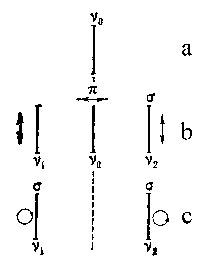Magnetic Fields
Our measurements of magnetic fields in active regions are based on The Zeeman effect.The lines reacting to a magnetic field by Zeeman's splitting exhibit an elliptic polarisation. Its axes are defined by an angle of an observing direction with a vector of measured magnetic field.
 In instruments, polarization effects of normal Zeeman splitting (to three components) are mostly used. We can see different demonstrations of Zeeman splitting according to an angle of view. There is an unsplit line on the a-part of the figure. If the magnetic field vector is parallel to the line of sight then we see only two circularly polarized components s (see figure part b). Component p is parallel with the magnetic field vector and both s components are perpendicular to this vector. A magnetic field vector is influenced by the addition of circular and linear polarisation of s components. Two elliptically polarized s components are formed with one linearly polarized p component between them. The vector of the magnetic field can be derived from our measurements of these components.
In instruments, polarization effects of normal Zeeman splitting (to three components) are mostly used. We can see different demonstrations of Zeeman splitting according to an angle of view. There is an unsplit line on the a-part of the figure. If the magnetic field vector is parallel to the line of sight then we see only two circularly polarized components s (see figure part b). Component p is parallel with the magnetic field vector and both s components are perpendicular to this vector. A magnetic field vector is influenced by the addition of circular and linear polarisation of s components. Two elliptically polarized s components are formed with one linearly polarized p component between them. The vector of the magnetic field can be derived from our measurements of these components.
Doppler Velocity Fields
When our magnetograph observes a selected spectral line, it requires the line to be stable on the block of output gratings. Doppler shift of the spectral line is compensated by automatic displacement of a thin glass plane-parallel board. This board refracts the light and shifts the line back to the position where intensities of both spectral line wings are equal. We can compute the Doppler velocity of the plasma in a selected point of the solar disk from the angular displacement of the plane-parallel board.This system is disadvantaged by the final velocity of the mechanical compensator and lower light sensitivity. We eliminate both of these limitations during primary data processing. The principle of this correction is based on the conversion of uncompensated signals measured in both spectral line wings to the equipotent Doppler velocity. This correction is realized locally in each point of a measured region.